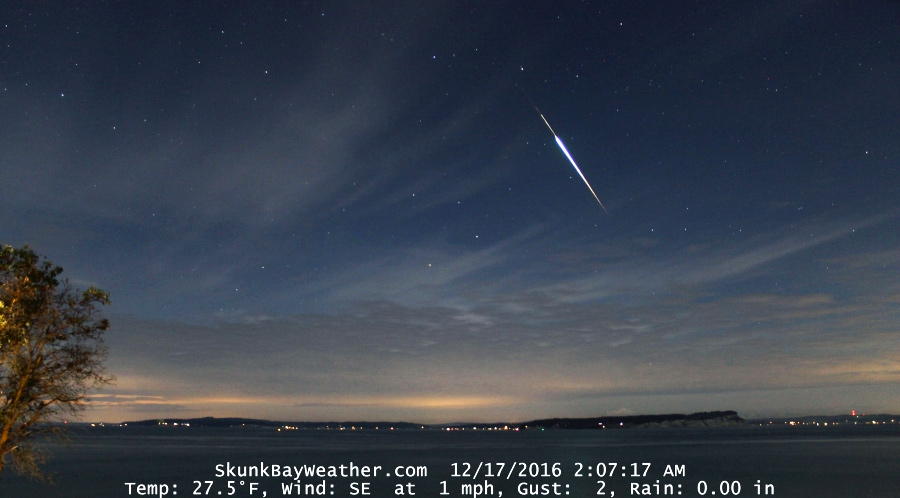
Canon T3 Rebel 18-55mm lens at wide angle, Av 3.5, Exposure 20sec. , ISO 1600. This camera is installed as a dedicate night webcam using Sebectec software.
During this period the moon wanes from slightly less than half illuminated to nearly new, when it will be to thin and too close to the sun to see. This weekend the waning crescent moon will rise during the early morning hours and will interfere with viewing meteors if you look in its direction. If you face away from the moon once it clears the horizon the moonlight will hardly be noticeable. The estimated total hourly meteor rates for evening observers this week is near 4 no matter your location. For morning observers the estimated total hourly rates should be near 9 as seen from mid-northern latitudes (45N) and 10 as seen from tropical southern locations (25S). Morning rates are slightly reduced during this period due to lunar interference. The actual rates will also depend on factors such as personal light and motion perception, local weather conditions, alertness and experience in watching meteor activity. Note that the hourly rates listed below are estimates as viewed from dark sky sites away from urban light sources. Observers viewing from urban areas will see less activity as only the brightest meteors will be visible from such locations.
The radiant (the area of the sky where meteors appear to shoot from) positions and rates listed below are exact for Saturday night/Sunday morning January 21/22. These positions do not change greatly day to day so the listed coordinates may be used during this entire period. Most star atlases (available at science stores and planetariums) will provide maps with grid lines of the celestial coordinates so that you may find out exactly where these positions are located in the sky. A planisphere or computer planetarium program is also useful in showing the sky at any time of night on any date of the year. Activity from each radiant is best seen when it is positioned highest in the sky, either due north or south along the meridian, depending on your latitude. It must be remembered that meteor activity is rarely seen at the radiant position. Rather they shoot outwards from the radiant so it is best to center your field of view so that the radiant lies at the edge and not the center. Viewing there will allow you to easily trace the path of each meteor back to the radiant (if it is a shower member) or in another direction if it is a sporadic. Meteor activity is not seen from radiants that are located below the horizon. The positions below are listed in a west to east manner in order of right ascension (celestial longitude). The positions listed first are located further west therefore are accessible earlier in the night while those listed further down the list rise later in the night.
These sources of meteoric activity are expected to be active this week.
The center of the large Anthelion (ANT) radiant is currently located at 08:56 (134) +17. This position lies in central Cancer, 3 degrees southeast of the 4th magnitude star known as Asellus Australis (delta Cancri). Due to the large size of this radiant, Anthelion activity may also appear from western Leo, northwestern Hydra, and eastern Gemini as well as Cancer. This radiant is best placed near 0100 local standard time (LST), when it lies on the meridian and is located highest in the sky. Rates at this time should be near 2 per hour as seen from the northern hemisphere and 1 per hour from south of the equator. With an entry velocity of 30 km/sec., the average Anthelion meteor would be of slow velocity.
The January Comae Berenicids (JCO) were first detected by Dr. Peter Jenniskens and mentioned in his book: Meteor Showers and their Parent Comets. These meteors are best seen from January 21-27 with maximum occurring on the 24th. At maximum the radiant is located at 12:52 (193) +15. This position lies in southern Coma Berenicids, 5 degrees northwest of the 3rd magnitude star known as Vindemiatrix (Epsilon Virginis). Hourly rates during this period would be less than 1 no matter your location. These meteors are best seen near 0400 LST, when the radiant lies highest above the horizon. These meteors encounter the atmosphere at 65 km/sec., which would produce meteors of swift velocity.
The Eta Corvids (ECV) were discovered by Sirko Molau and Juergen Rendtel while analyzing the data from the IMO network of video cameras. This shower is best seen from January 18-26, with maximum activity occurring on the 23rd. The radiant is currently located at 12:54 (194) -18. This position lies in eastern Corvus, 3 degrees southeast of the close pair of naked eye stars known as eta and delta Corvi. The IMO database has only 300 members of this shower so meteors would be fairly scarce with hourly rates less than 1, even at maximum activity. These meteors encounter the atmosphere at 69 km/sec., which would produce meteors of swift velocity. These meteors are best seen near 0500 LST, when the radiant lies highest above the horizon.
The Gamma Ursae Minorids (GUM) were discovered by Peter Brown and his associates at the University of Western Ontario. These meteors are active from January 18-24, with maximum occurring on the 20th. At maximum the location of the radiant is 15:12 (228) +67, which places it southern Ursa Minor, 5 degrees south of the 3rd magnitude star known as Pherkad (gamma Ursae Minoris). These meteors are best seen during the last few hours before dawn, when the radiant lies highest in a dark sky. Like most showers active during this period the hourly rates would most likely be low, less than 1 per hour no matter your location. These meteors encounter the atmosphere at 30 km/sec., which would produce meteors of medium-slow velocity.
As seen from the mid-northern hemisphere (45N) one would expect to see approximately 7 sporadic meteors per hour during the last hour before dawn as seen from rural observing sites. Evening rates would be near 3 per hour. As seen from the tropical southern latitudes (25S), morning rates would be near 9 per hour as seen from rural observing sites and 3 per hour during the evening hours. Locations between these two extremes would see activity between the listed figures.
| SHOWER | DATE OF MAXIMUM ACTIVITY | CELESTIAL POSITION | ENTRY VELOCITY | CULMINATION | HOURLY RATE | CLASS |
| RA (RA in Deg.) DEC | Km/Sec | Local Standard Time | North-South | |||
| Anthelion (ANT) | – | 08:56 (134) +17 | 30 | 01:00 | 2 -1 | II |
| January Comae Berenicids (JCO) | Dec 20 | 12:52 (193) +15 | 65 | 05:00 | <1 – <1 | IV |
| eta Corvids (ECV) | Jan 23 | 12:54 (194) -18 | 41 | 05:00 | <1 – <1 | IV |
| gamma Ursae Minorids (GUM) | Jan 20 | 15:12 (228) +67 | 31 | 07:00 | <1 – <1 | IV |


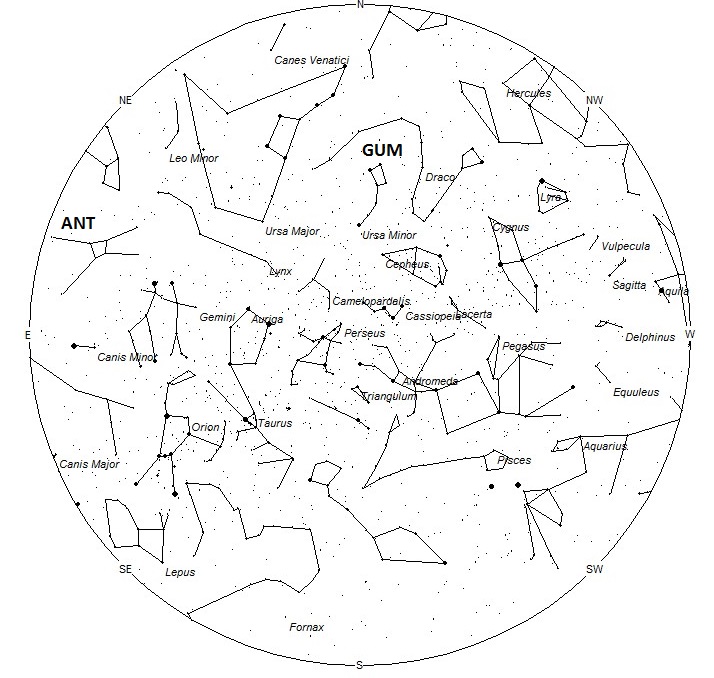
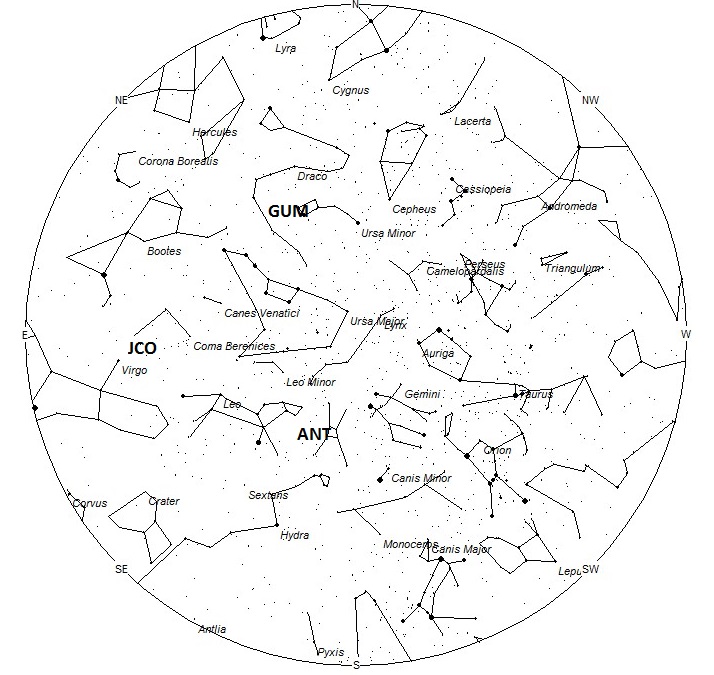
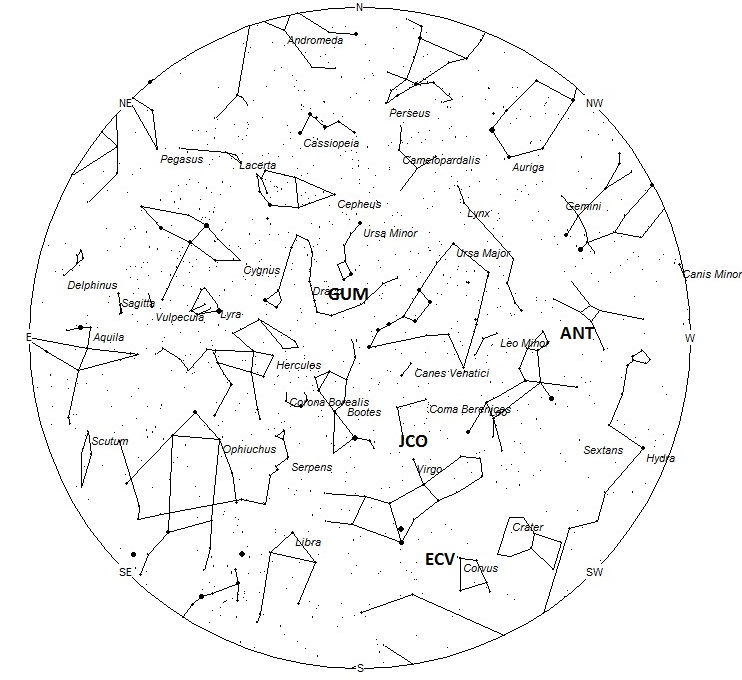

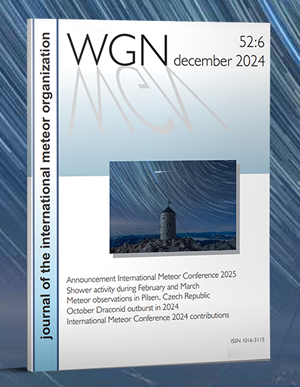
 You saw something bright and fast? Like a huge shooting star? Report it: it may be a fireball.
You saw something bright and fast? Like a huge shooting star? Report it: it may be a fireball.  You counted meteors last night? Share your results with us!
You counted meteors last night? Share your results with us!  You took a photo of a meteor or fireball? You have a screenshot of your cam? Share it with us!
You took a photo of a meteor or fireball? You have a screenshot of your cam? Share it with us!  You caught a meteor or fireball on video? Share your video with us!
You caught a meteor or fireball on video? Share your video with us!